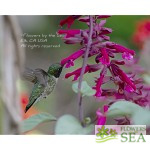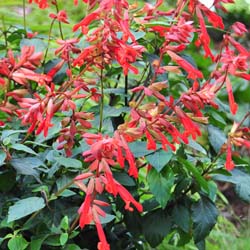(Kisses and Wishes Sage) Blooming over multiple seasons, Salvia ‘Kisses and Wishes’ bursts with long, luminous, rosy pink blossoms nestled in pink-to-gold bracts. It’s so pretty that it seems unfair to refer to the newest member of the Wish Sages as a “mutation.”
In 2015, Jane Knott of West Sussex, England, discovered that part of her Wendy’s Wish Sage (Salvia x ‘Wendy’s Wish’) looked different from the rest of the plant. It was a “sport,” which is another, jauntier way of saying mutation. The growth didn’t have Wendy's magenta pink flowers and mauve bracts.
Wendy’s Wish is an accidental hybrid that Wendy Smith found in her Victoria, Australia, garden in 2005. It’s uncertain what plants crossed to produce Wendy’s Wish, but there were a variety of sages near the seedling including S. Buchanani, S. chiapensis, S. mexicana ‘Lolly’, S. guaranitica ‘Purple Majesty’, and a red S. splendens. This New World genetic pool produced what has become a renowned as a hummingbird favorite.
Kisses and Wishes isn’t the first sport in the Wish series. In 2012, the coral-flowered S. x ‘Ember’s Wish’ sported on a Wendy’s Wish Sage at Plant Grower’s Australia. Then Australian retiree John Fisher propagated the purple flowered hybrid, S. x ‘Love and Wishes’.
All Wish Sages grow well in full sun, but appreciate a bit of partial shade where summers are hot. Like the rest of these beauties, Kisses and Wishes Sage needs average watering and good soil drainage.








